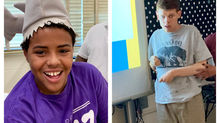Ready to Build Independent Typing Skills?
- Lisa Mihalich Quinn

- Jan 17, 2023
- 3 min read
Updated: Jan 18, 2023
“I want my child / student to be able to type without someone holding the keyboard. How do we make this happen?”

This is the number one question we get asked by parents and professionals. Like all things involving our students, there’s no one right answer! But let’s explore some first steps that will be useful to everyone.
First, let’s start by reframing the question. “How do I help my students take steps toward more independent communication?” This new question acknowledges that this is a process, something that takes time and practice. Often, when we want something for our students, we place a lot of pressure on ourselves and them to make this our focus. At Reach Every Voice, we’ve found that one of the best ways to work toward a big goal is to acknowledge that it won’t happen overnight.
How do we know that our students feel the pressure? They’ve told us.
I teach a six-week course called Building Independent Typing Skills, which offers strategies and tools to build these skills. It also brings students together in a supportive community where they are comfortable sharing their feelings about the process.
The first thing I hear again and again is “I’m afraid of making mistakes.” Can you relate to this? I know I can. Trying new things is SCARY. Trying new things that are also HARD can be even more petrifying. But you know what? We all make mistakes. I make SO many mistakes on a daily basis. But I am more comfortable taking a risk that might lead to a mistake if I feel like I’m supported. So as we work toward building more independence, we want our students to be working with a partner they trust and feel supported in the journey.
I also hear, “This makes me anxious.” Anxiety is very real. And it can be crippling. - BUT - anxiety can also be productive in small doses or in the right situation. We work with our students to channel this anxiety into motivation while also making sure they feel supported. It’s okay to feel anxious, and we remind our students that we’re all in this together.
Also, when we reframe the question to ask what steps we can take toward more independent communication, we acknowledge that this isn’t an all or nothing situation. Our students develop communication skills with a variety of supports in place. It would be unrealistic to think that a student who still requires prompts with a board held by their communication partner will be able to suddenly communicate on a flat keyboard with no prompting or regulation support.
Taking the first steps toward any more independent practice requires us to reduce the prompts we use at the student’s most proficient level first and then recognize the need to increase them as we change a physical setup. If I have a student who requires a lot of verbal prompts to keep going or be precise with which letters they are touching, my first step toward more independence would be to work to reduce those prompts. If I have a student who requires few or no prompts using a held keyboard or letterboard, my first step toward more independence would be to place the keyboard on a stable surface (desk / stand) and actually increase my prompts to help the student adjust to the new motor demand.
It’s easy to see how this can be overwhelming for our students, right? That’s why we focus on the journey. If you come to any of my classes, you’ll hear me repeat the phrase, “progress, not perfection” again and again. If we want to work toward more independence we have to be confident taking just the first step and recognizing that for the huge odyssey it is.


























.png)

.png)



.png)


Comments